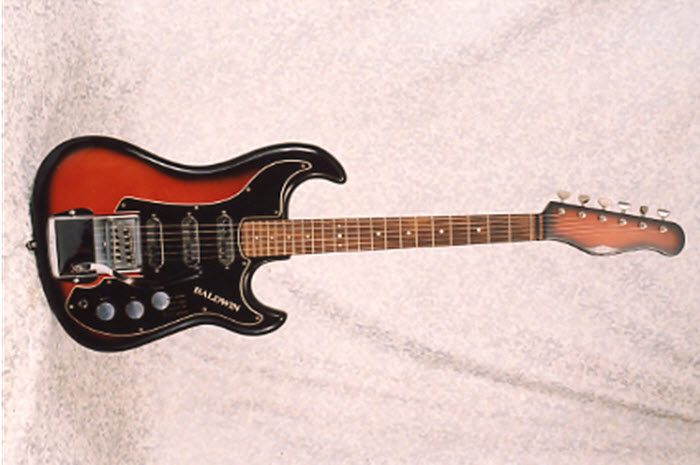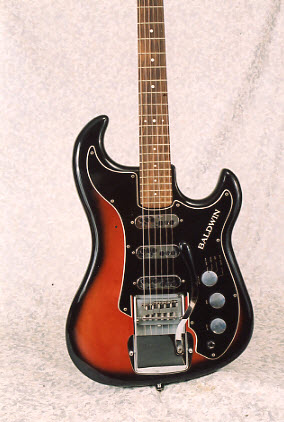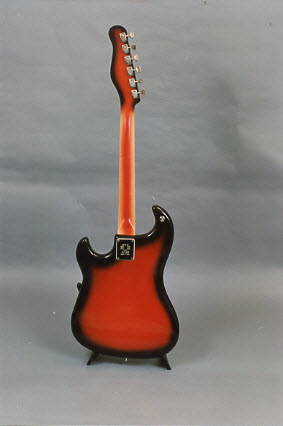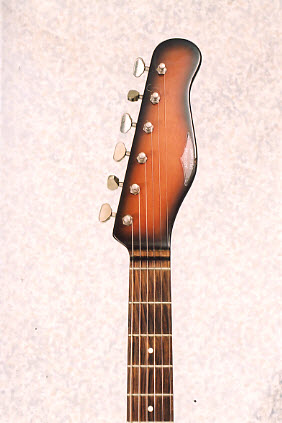
Go ahead, admit it. If someone told you there was a cool Sixties guitar with a factory setting called “Wild Dog” (or maybe even one called “Split-Sound”), you’d want one, wouldn’t you? Of course you would. That’s why, once I found out about the Burns Jazz Split-Sound, it went straight to the top of my wish list. But sometimes when you get what you wish for it doesn’t live up to the hype!

Vintage 1965 Baldwin Burns Jazz Split-Sound Electric Guitar
I finally found my Wild Dog on, of all things, the inventory list of George Gruhn, the eminent Nashville vintage guitar dealer. Now, that may not seem odd to you, but this was a long time ago. Back then finding guitars was done by eagerly getting the first printing of the Trading Times, a weekly newsprint want-ad rag that was published all over the country in localized versions. If you’re one of those young-uns who walks around with your nose in a smart-phone, “want-ads” were notices you paid to put in the paper if you had something to sell. EBay didn’t exist. Only Al Gore used the Internet. George’s list wasn’t in the Trading Times, but in Vintage Guitar Magazine, which was the Trading Times for old guitar junkies.
Anyhow, I got this 1965 Baldwin-Burns Jazz Split-Sound from George Gruhn for what I thought was a high price at the time, but it was a relative bargain at Gruhn’s because this was the time when everyone was still looking for vintage Strats and Les Pauls (before they cost 5 to 6 figures), not Baldwin-Burns guitars. So, this wasn’t on the radar at the time. Except for someone like me. There’s a reason I’m billed as “The Different Strummer.”

Vintage 1965 Baldwin Burns Jazz Split-Sound Electric Guitar
Baldwin-Burns guitars are part of the madness that was the 1960s guitar industry. Baby Boomers like me liked guitars and corporations with money started buying up guitar manufacturers. CBS and Fender, Norlin and Gibson, etc., etc. Among the early suitors for Fender was the Baldwin Piano and Organ company of Cincinnati. When Fender went on the block in 1965 due to Leo’s health problems, Baldwin tried to buy the company. CBS outbid them and that was that. At the same time, Burns of London, owned by Jim Burns, was having financial difficulties. Burns was more guitar “genius” than business wizard. The plan was to import Burns-designed and produced guitars carrying the Baldwin name. The first units began to arrive in late 1965 and this was a very early arrival of the Jazz Split-Sound model.

Vintage 1965 Baldwin Burns Jazz Split-Sound Electric Guitar
Actually, this is pretty interesting in a number of dimensions. First of all, it’s a “Strat” configuration, although pretty liberally interpreted, with “notes” of the Burns Bison. Back in the mid-‘60s Fender’s top guitars were the Jazzmaster and Jaguar, which were most copied by both European and Japanese manufacturers. It’s early because of the head, which became a scroll design in mid-1966. Like I said, Jim Burns was a pretty good guitar designer and this has one of his Series 2 adjustable vibratos. The pickups are a pretty interesting take on a humbucker, really kind of a hybrid, with offset coils and poles. This is, no doubt, the origin of the “Split-Sound” nomination. These are pretty cool, because the “Split-Sound” meant that the neck coils captured the bass strings and the bridge coils got the trebles. I’m not really sure you can hear the subtleties, but it’s dang cool none-the-less.

Vintage 1965 Baldwin Burns Jazz Split-Sound Electric Guitar
The “Wild Dog” setting is, well, underwhelming. It’s basically an out-of-phase sound like you get in the in-between positions on a Strat, but the pickups aren’t really as hot as a Strat’s, so, while it’s cool—and pretty innovative—in a ’60s guitar, it’s really no big whoop. But good marketing!
This is, for the times, a professional grade instrument, on a par with Fender or Gibson, with an entirely unique feel, of course. Burns doesn’t get the respect he deserves in the American market, and the Baldwin—and later Ampeg—monikers didn’t help with credibility, given the consumer illusion that a brand name had to equate with the manufacturer. Which it almost never has.

Vintage 1965 Baldwin Burns Jazz Split-Sound Electric Guitar
Despite all the technical features that make this guitar desirable, there really isn’t any “Wild Dog” there. Maybe compared to a Kay or a Harmony electric. And to get Wild Dog out of a Strat, you needed toothpicks. Nada on Gibsons.
That the “Wild Dog” setting was kind of disappointing doesn’t diminish the coolness of this guitar, but it certainly wasn’t what I expected. More like “Big Whoop.” But pretty good marketing!

I just purchased a Burns Ampeg wild dog splitsound guitar which my buddy played in our original garage band in the 80’s called Plan 9 from the voted worst of all time sci- fi movies Plan 9 from outer space. I played a Burns Bison, pea green, very light and with the scroll top headstock. Not a Baldwin Baby Bison! I’m not not having much luck finding an original, with the big horns that actually ended up pointing back at the neck! Quality wise maybe not the best but we loved them because people didn’t know what the hell we were playing and they looked different, cool. Anyway if you ever have something close I would appreciate an e-mail. Sorry about being long winded, but if you love music and guitars I think you will forgive me…….thanks…..Mike Ripa
Wow! Plan 9? There’s a blast from the past! Bomp records? Or is my hemp-stained cranium having some memory issues? Just a whale searching for a porpoise?
Groovy guitar, but I’d rather have my long lost Yamaha SG-3 12 string, with it’s amazingly groovy pickups and wiring scheme!
A green Bison would be extraordinarily rare. The factory offered them in only black or white, although The Burns people were known to do an occasional one off. the Baldwin/Burns saga is sadly marked by a series of missteps and Baldwin understanding the piano market but being pretty much in the dark as far as guitars and those who play them were concerned. Their only signature artist early on was Hank Marvin, an amazing player, wildly popular in Britain but largely unknown to the American kids who were their target.Later on they got one hit wonders, The American Breed, Jerry Reed, and even Willie Nelson on board but by then the brand was dead in the water and Baldwin bought Gretsch and abandoned the Burns line. Willie still uses a Baldwin amp with a Baldwin Prismatone pickup on his Martin guitar, Trigger. I love my Baldwins in all their quirky glory. Thanks for the article. (By the way…The Ampeg involvement pre-dates the Baldwin purchase.)
i first met one of these along with a Baldwin Eliminator amp (sort of the steroid-fueled big brother to the Baldwin that Willie Nelson uses to this day) at Mel Bay Music when they came out. I was in my early teens but the staff kind of knew me as a player and they let me fondle it and even plug it in (with the volume set at about negative 10). I also got the admonishment not to set it on Wild Dog. i did anyway and was unimpressed. Still, it’s cool as anything.
Mike Ripa…….hello, I am a huge Plan 9 fan. Are you saying Eric sold you his Ampeg guitar ? If so please, please take good care of it as I am sure you will. By the way do you recall what amp he was playing through in the early days it was an Ampeg I think but what model was it ? I did not get hip to the band till Keep Your Cool era…….I went to alot of shows around that time and still after all these years really love the band. Those early records you played on are really fantastic.
Oddly enough it was listening to Plan 9 that finally made me commit to playing guitar….Eric turned down my request for lessons at one point….and I dont fault him for it but I wonder what I may have become under his tutelage. I live in CA. now and have lost touch but I suppose I should write Deb and Eric to thank them again for all the hours of joy their music has brought to my life and I thank you too.
I hope you see this note sometime and feel free to drop a line if compelled to: dennis.forry@gmail.com
I have an Ampeg/Burns Wild Dog purchased new in the early 60’s from Manny’s Music. I used it extensively in my garage band days, and have played it off and on since then. The playability and finish seem unfazed by many years moderate abuse. It was a wonderful investment that still provides some fun. Never did figure out what that Wild Dog sound was supposed to be.
I own half-a-dozen Burns guitars. Their labelling does not describe the tone settings they can produce. My 1963 Split Sound Baritone/Bass (24.75 neck and tremolo arm !!!), when set to Jazz, produces exactly that tone found on Sunshine of Your Love. Unsurprisingly, Jack Bruce had on e of these rare instruments. Anyone who has a Bison with the A-B Switch and the four-tone dial will know that it produces eight radically different tones, all very 1960s, from Woman Tone to wiry Surf sounds. Jim Burns gave his customers something that all guitar makers should be obliged to offer – he wired up every possible combination of pickups in the cradle, so that a three pick-up guitar offered seven sound combinations.
I have a 1963 burns split sound excellent condition. Anyone interested email me please
Several of the early sixties Burns guitars had the “split-sound” feature and the “wild dog” tone (the Bison, Split Sonic and Jazz Split Sound).
I have been a Burns fan since 1964 when I purchased my first Burns, but for me the split-sound feature and wild dog tone setting were nothing more than a gimmick – only if you played finger style did the split-sound feature seem to have any advantage, with the E, A and D strings from one pickup mixed with the G, B and E strings of a different pickup.
The “wild dog” tone was (to my ears) a very piercing, but thin, treble sound, with only a few possible applications (like, say, “Man of Mystery” or “Midnight” by the Shadows) and where the lead guitar had to cut through the sound of the rest of the band (especially if you had a loud drummer)! But for the most part, the “split-sound” pickups and wild dog tone were a disappointment.
The Split Sonic guitar had a brother – the Vista Sonic, and the Jazz Split Sound guitar had a sister – the Short Scale Jazz. Each of these guitars had “normal” Tri-Sonic pickups – and (to my ears) both sounded better than the Split-Sound pickups.
Why Burns did not simply produce a 3 Tri-Sonic pickups Jazz (as well as the 2 Tri-Sonic pickups Short Scale Jazz) is a mystery. For me the 3 pickup Jazz looked great, but was let down by its Split-Sound pickups – 3 Tri-Sonics would have made it a great guitar.
I have a 2 pickup Short Scale Jazz (with Tri-Sonic pickups) and can vouch that it is an excellent sounding guitar. The pickups are excellent for clean and distorted sounds and the guitar really sings through a Marshal!
Unfortunately, as with the Split Sonic, the Jazz Split Sound catches the eye, but not the ear!
Back in the early 1970’s I put together my first jazz-rock band and needed an electric guitar at short notice. My friend Rick very generously lent me his immaculate black Burns Bison. At our first gig I recall that my friend the late blues singer Roger Barnes kept shouting, “Give it some more ‘wild dog’ Andy”, much to the amusement of me and the rest of the band!
Since then I’ve owned several lovely guitars, including a Gibson Les Paul ‘Black Beauty’, Fenders Stratocaster & Telecaster, Tokai Strat., Yamaha SA2100 and Eastman AR 403 – lovely guitars all of them, but no Wild Dog!
I have a Sunburst Burns Bison made around 1963 and I am trying to locate a circuit diagram showing the ‘wild dog’ hook up. The guitar has been in bits for the last 30 years and I have been trying to restore it to it’s original condition. I have located all the parts I need but the wiring diagram has been difficult to locate. Any help would be appreciated. My Bison has 3 pickups.
I have a 1963 Burns of London/Ampeg Wild Dog 6 string in very very good condition in the original case and has the tool kit with it. I am willing to sell it. The head stock says jazz guitar/split sound. The pickguard says Ampeg bu Burns of London. It is all there. Complete and original and plays excellent. The book Pearls and Crazy Diamonds about 50 years of Burns guitars 1952-2002 comes with it $1600.
A sunburst 3 pup Bison sounds like a nice onel. is it original or a re- fin? Do you want to sell it?
I have a translucent cherry red model 1963 which is very rare and maybe the first of only 5 ever made in this colour.
Message to Eddie Steadman.
Eddie you needed a circuit for your Bison. Here is one that may well suit you.
Just click on the below link then click on ‘supporting information’ you will see photos of guitars and a circuit with Wild Dog that you will hopefully find is what you need.
I could still be interested in buying your Bison bits if you ever sell it. Please let me know via this site and Zi will send you my contact details.
Cheers
Ray
http://www.trevormidgley.com/BurnsGuitars/SGBison.ht
ml
I own and love this guitar. However, I altered the internal wiring. For one thing, there is a “strangle” cap through which all PU´s go, except for the neck PU; I just wired a jumper across it. Now the “Treble” setting has a lot more body to it. Second, I rewired the “Wild Dog” position in such a way that it would only give me the mid-PU on its own. The neck PU has a separate tranformer of its own; I rewired it so that it will couple through the same transformer as the other two PU´s (now it has more treble, doesn´t sound so “whoofy”). Lastly, I rewired the “Split Sound” setting; with all other PU settings, you get a humbucking arrangement, where both coils are wired in series. Not so with the “Split Sound”: the bass coil of the neck PU and the treble coil of the bridge PU run in paralell – hence a much weaker signal. I chnaged it so that the bass coil of the bridge PU and the treble PU of the mid PU are in series (and hum cancelling – the mid PU is out of phase with the other two). The result is a sound where the bass strings have a real country twang, while the treble strings sound a little fuller than they do in the “Treble” setting. The voicing is less radical, but all the more useful. Plus: it can all be returned to a factory original setting, if desired.
I sold my 1965 Baldwin twin about 5/7 years ago to a music store some where in N Y state. I live in Florida. It was my first electric. Photo’s are exactly like the one I owned. Article brings back memories. ROCK ON !!!!